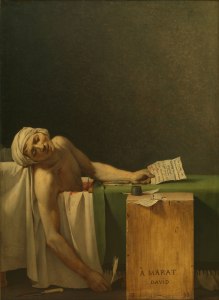 Last week I devoured Mervyn Peake’s modernist fantasy classic,Titus Groan; over the weekend I read another unclassifiable novel, Steven Brust’s The Sun, The Moon, and the Stars.
Last week I devoured Mervyn Peake’s modernist fantasy classic,Titus Groan; over the weekend I read another unclassifiable novel, Steven Brust’s The Sun, The Moon, and the Stars.
I picked up this lovely hardcover book because it is the first in the splendid “Fairy Tale Series” edited by Terri Windling, who recruited several fantasy writers to retell fairy tales for adults. Some of the versions are traditional; others have a more original slant. The gorgeous covers were designed by Thomas Canty.
The Sun, The Moon, and the Stars (1987) is a clever, carefully-crafted account of an artist’s struggle to create. The narrator, Greg Kovacs, shares a studio with four artists in Minnesota. After dropping out of college, he earned a degree in drafting, but he has never had a drafting job, because his photographer girlfriend supports him. Sometimes he fells guilty that she has sacrificed her art so he can paint. He does not sell his work, nor do his friends. And they are approaching a crisis in the studio: they need to have a show or break up.
I am fascinated by Greg’s work: he is creating his own myth about the Greek gods Uranus (Sky), Apollo, and Artemis, and painting it on a giant canvas he calls the Monster. But it is the structure of the book that dazzles me.
Each chapter is divided into six short sections, and each section bears the title of a painting. (I didn’t figure that out until I was well into the book.) I am sure the paintings relate to the text, and I look forward to rereading this with an art history book in hand (or, more likely, Wikipedia).
The narrative describes Greg’s aggressive interactions with friends, and also his strong-minded philosophy of art. He opposes modern, abstract art, but the book is modernist.
He is completely unpretentious. He needs to look at art constantly. In a section called “The Death of Marat,” Greg tells us that he looks at prints for inspiration. Looking at the real paintings is the ideal.
He gets to know famous artists through their work. He writes,
I do know artists who say, ‘I can’t look at other people’s work while I’m painting because their style creeps in.’ The first time I heard that, I did a cartoon of Gauguin’s style creeping into Cezanne’s work, and I called it, “Such tragedy.” I thought it was pretty obvious, but the people who ought to get it never do.
The other artists are slowly sketched in, though we don’t get to know them well. They ruthlessly criticize each other’s work. Greg is very aggressive, and spares only. Karen, the only woman, who paints landscapes and has no talent, he thinks. (The others suggest he is sexist; his girlfriend Debbie reminds him that he doesn’t even help with the housework.) The brilliant Dan works in a style Karen calls “post-urban subway.” David is a body-builder. (Naturally, I thought of the sculpture.) Rob likes to go dancing at night.
In every chapter, one section is devoted to Greg’s telling the others a Hungarian folk tale he half-remembers, half-invents. A taltos (wizard) has said he will put the sun, moon and stars in the sky in exchange for king’s daughter and half the kingdom. And then there will be light! He takes his two brothers to help. There is fighting of dragons and their human wives and mothers-in-law. The tale is half-humorous. I am frankly baffled by how it fits in with the rest. I will pay more attention to it next time. (Yes, I will reread it.)
I very much enjoyed this short novel. The writing isn’t perfect, but the perfect structure shows off the writer’s brilliance. The book has elements of fantasy, but can be read as a realistic novel about art.
Steven Brust says of The Sun, the Moon, and the Stars :
I think at a certain point, every writer has to ask himself why he writes, and what he’s hoping to do. I wrote this one to answer that question…. I have mixed feelings about it—I think I did all right with it, but it is too personal to have a very wide appeal. Still, I’m glad I wrote it, and I’m always pleased to run into people who like it.


An intriguing sounding title and one I hadn’t heard of – plus the cover is gorgeous!
LikeLike
This is a very interesting novel, and an excellent series. Pamela Dean wrote Tam Lin was written for it. (I’m always blogging about that one.) Brust and Dean are in the same writers’ group in Minneapolis! The editor got interested in them and commissioned novels.
LikeLiked by 1 person